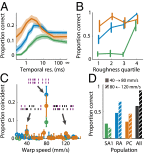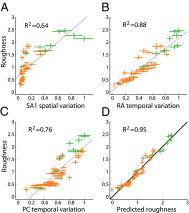Spatial and temporal codes mediate the tactile perception of natural textures
- PMID: 24082087
- PMCID: PMC3800989
- DOI: 10.1073/pnas.1305509110
Spatial and temporal codes mediate the tactile perception of natural textures
Abstract
When we run our fingers over the surface of an object, we acquire information about its microgeometry and material properties. Texture information is widely believed to be conveyed in spatial patterns of activation evoked across one of three populations of cutaneous mechanoreceptive afferents that innervate the fingertips. Here, we record the responses evoked in individual cutaneous afferents in Rhesus macaques as we scan a diverse set of natural textures across their fingertips using a custom-made rotating drum stimulator. We show that a spatial mechanism can only account for the processing of coarse textures. Information about most natural textures, however, is conveyed through precise temporal spiking patterns in afferent responses, driven by high-frequency skin vibrations elicited during scanning. Furthermore, these texture-specific spiking patterns predictably dilate or contract in time with changes in scanning speed; the systematic effect of speed on neuronal activity suggests that it can be reversed to achieve perceptual constancy across speeds. The proposed temporal coding mechanism involves converting the fine spatial structure of the surface into a temporal spiking pattern, shaped in part by the mechanical properties of the skin, and ascribes an additional function to vibration-sensitive mechanoreceptive afferents. This temporal mechanism complements the spatial one and greatly extends the range of tangible textures. We show that a combination of spatial and temporal mechanisms, mediated by all three populations of afferents, accounts for perceptual judgments of texture.
Keywords: neurophysiology; psychophysics; roughness; spike timing; touch.
Conflict of interest statement
The authors declare no conflict of interest.
Figures





References
Publication types
MeSH terms
LinkOut - more resources
Full Text Sources
Other Literature Sources

